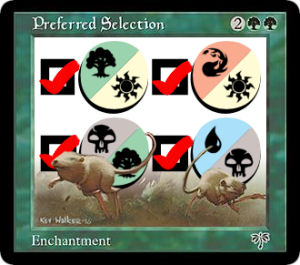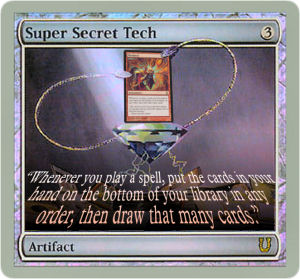I apologize for my delay in writing about Ravnica Limited, leaving you to get advice from such masters of the game as Scott Wills, Nick Eisel and John Pelcak. My reasons are twofold.
First, I put a lot of time into testing Standard for Worlds, and came out with what I believe to be the best deck in the format. Unfortunately, I didn’t put the same effort into Extended. I missed the money, after being 9-3, because of that.
Second, it’s been difficult to pull myself away from triple Ravnica drafts on MTGO, due to it being such an interesting format, and also because my laziness is unequalled. So here I am, writing this article partly because Ted said I would – and it’s not my place to break his promises – and partly because my “mother” is forcing me to do so.

In this article, I will describe my favourite archetype in the format, and how to approach drafting it.
The color combination I prefer, above all others, is… all of them.
From the moment I saw the Ravnica spoiler, I believed Civic Wayfinder to be the best common. Since then, only Faith’s Fetters and Last Gasp have convinced me otherwise. With this in mind, I first started drafting the set looking for ways to abuse the Wayfinder. The obvious benefit is simple: it allows you to play fewer lands, with more colors, and that’s just what I did. Through trial and error I have found that you usually want to play either fifteen or sixteen lands, depending on how many mana fixers and double lands you have, and about four colors.
Since Ravnica Limited is vastly different from any previous format, making a pick order for the archetype doesn’t seem like it would work in this instance. Especially since any pick order encompass all five colors. The best way to describe how to draft this deck involves dividing it into sections.
The first, and most important section, is solid creatures and removal spells. After that, the next worry is mana fixers. Finally once you have a solid base of creatures and spells, and enough mana fix to cast your powerful off-colour spells, you can look into picking them up.
When I draft this archetype it almost always starts out the same way. I start my draft with a Green creature or a Black removal spell. From there I move into a base-Green deck, with either Black or White as a secondary color. From this base, I hope to pick up the solid creatures and removal spells that make up the core of the deck.
Having good creatures, and removal spells you can reliably cast early, allows you to do crazy things with your mana. You can stabilise the early game, and take your time finding the colored mana necessary to cast your off-color bombs.
The second section involves the mana base. The most important mana fixer is Civic Wayfinder, since he finds you a new color of your choosing, and can also hold off creatures in the early game. He puts your opponent in a no-win situation. Either they attack into the Wayfinder, losing their creature and giving you card advantage, or they allow it to hold them off and sacrifice whatever tempo advantage they’ve built.
For mana-fixing, the four Signets are of secondary importance. They are superior to Farseek, as they provide two colors and you only lose a single mana on the turn they hit play. Early in the draft, I generally take the Green Signets higher until I have established which colors I’m playing. At this point, I obviously take the Signets of the appropriate splash colors higher.
Of lesser importance, but still worth taking into consideration, are Farseek and Elves of Deep Shadow. At first glance, it may seem that Farseek would be the second-best mana-fixer, after Civic Wayfinder, because it can find you whatever colour you happen to be missing. However, it has two issues in relation to the Signets, in addition to those previously mentioned. First, we have the inability to find a second Green source. This is much more important than it first appears. Since the deck is mostly Green, it is imperative to cast your double-Green spells early in the game. Sometimes you will get run over by the horde of terrible creatures that Red / White can spit out, staring at the Golgari Brownscale and Bramble Elemental in your hand, incapable of casting anything as you have Farseek instead of a Signet. Second, I like to play Signets of both my splash colors; most often, the Boros Signet in my G/b/r/w decks. In a G/b/r/w deck, you should wait until you draw a card from one of your splash colors, or another color of mana, to prevent you wasting Farseek on a largely useless land.
Splashing cards happens in two ways. Sometimes, you will open an extremely powerful card that shares a color with one of your main colors. Lightning Helix, for example, or Ribbons of Night. In these instances, you will look for the correct Signets and double-lands to allow these splashes, as well as other powerful cards to splash. The second way it happen is this: you start with a base-Green deck, but around your sixth or seventh pick there are no cards to fit a two colour deck. There may be, however, a Vedalken Dismisser or a Fiery Conclusion, both of which would fit well into your Convoke deck. Since you aren’t really losing a pick you can take these cards, with the intention of splashing them if you get the correct mana fix, but happily leave them on the bench if the fixers don’t appear.
My preferred splash cards are obvious, with a couple of notable exceptions. They need to be powerful effects, with a single coloured mana, although I will admit to splashing Cyrulean Sphynx and Szadek, Lord of Secrets once or twice. I often find myself splashing Blue for Vedalken Dismisser and Compulsive Research, Black for Disembowel and Last Gasp, Red for Galvanic Arc and Fiery Conclusion, and White for Faith’s Fetters.

A special mention should be made for my favorite splash-card. This is why I get paid the big bucks, folks: for stealing other people’s tech and spreading the word to the masses. I wish I could say that I discovered this card, but I don’t think I’d even read the text before I was told it was good. In fact, the only person (to my knowledge) that figured out that this card isn’t the standard do-nothing Red rare, in the vein of Warp World and Confusion in the Ranks, is Neil Reeves. He’s also going to be ‘a little hot’ about me divulging his tech. since he will no longer be able to open one and be certain he is going to get it as a ninth pick.
The card I am talking about is Mindmoil.
I’ll give you a moment to read it. Now read it again. Have you figured out why it’s good? I hope so. If not, allow me to explain…
Having Mindmoil in play does a number of things. It allows you to cycle through your deck quite quickly, playing the best card out of each new hand you draw. If you have a bomb in your deck, such as Glare of Subdual or Tolsimir Wolfblood, it will only take a turn or two of “moiling” to find it. It also means you will never run out of gas. Once you have Mindmoil in play, you rarely need to play another land… so you cast a spell and ship the real estate to the bottom. You’ll find another spell in the three or four cards you draw.
Obviously, Mindmoil isn’t the best draw in the lategame, or when the game has devolved into a topdecking war… but it also isn’t the worst. A couple of turns down the road, once you’ve drawn into a spell, you can ship the useless lands you’ve drawn to the bottom and get down to business.
I hope this has been helpful, and hope you will give this archetype a try. If that means my decks are getting worse because people are taking my Civic Wayfinders and Mindmoils, then so be it.
Check out my next article, a walkthrough giving you an example of how I draft this deck. I will try to answer any questions or concerns in the forums, and will also try to write more often (in the slim chance that that’s what people want).
Thanks for your time,
Rich Hoaen
